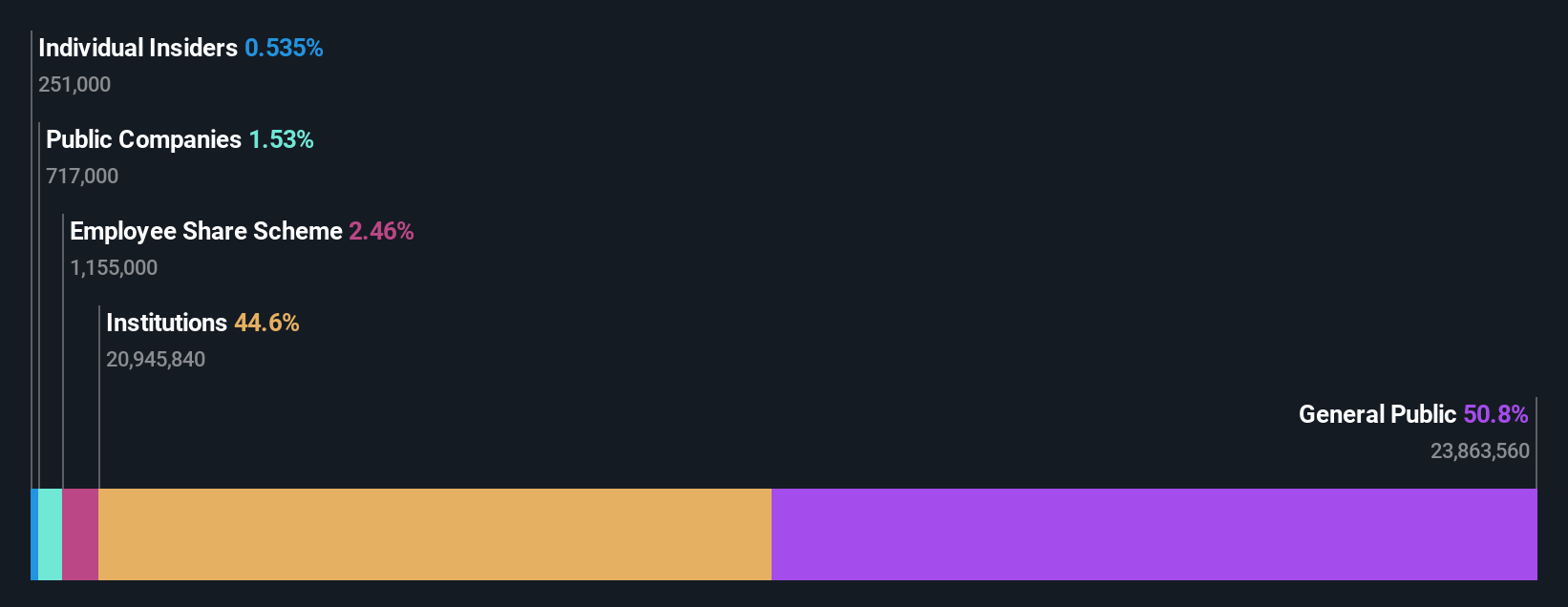Institutions profited after Tsugami Corporation's (TSE:6101) market cap rose JP¥8.1b last week but retail investors profited the most
Key Insights
- Significant control over Tsugami by retail investors implies that the general public has more power to influence management and governance-related decisions
- The top 25 shareholders own 48% of the company
- 45% of Tsugami is held by Institutions
A look at the shareholders of Tsugami Corporation (TSE:6101) can tell us which group is most powerful. And the group that holds the biggest piece of the pie are retail investors with 51% ownership. That is, the group stands to benefit the most if the stock rises (or lose the most if there is a downturn).
While retail investors were the group that benefitted the most from last week’s JP¥8.1b market cap gain, institutions too had a 45% share in those profits.
Let's take a closer look to see what the different types of shareholders can tell us about Tsugami.
See our latest analysis for Tsugami

What Does The Institutional Ownership Tell Us About Tsugami?
Many institutions measure their performance against an index that approximates the local market. So they usually pay more attention to companies that are included in major indices.
As you can see, institutional investors have a fair amount of stake in Tsugami. This implies the analysts working for those institutions have looked at the stock and they like it. But just like anyone else, they could be wrong. It is not uncommon to see a big share price drop if two large institutional investors try to sell out of a stock at the same time. So it is worth checking the past earnings trajectory of Tsugami, (below). Of course, keep in mind that there are other factors to consider, too.

Hedge funds don't have many shares in Tsugami. Looking at our data, we can see that the largest shareholder is Asset Management One Co., Ltd. with 4.9% of shares outstanding. The second and third largest shareholders are Hokuetsu Bank, Ltd. and Baillie Gifford & Co., with an equal amount of shares to their name at 4.7%.
Our studies suggest that the top 25 shareholders collectively control less than half of the company's shares, meaning that the company's shares are widely disseminated and there is no dominant shareholder.
Researching institutional ownership is a good way to gauge and filter a stock's expected performance. The same can be achieved by studying analyst sentiments. Our information suggests that there isn't any analyst coverage of the stock, so it is probably little known.
Insider Ownership Of Tsugami
The definition of an insider can differ slightly between different countries, but members of the board of directors always count. Management ultimately answers to the board. However, it is not uncommon for managers to be executive board members, especially if they are a founder or the CEO.
Most consider insider ownership a positive because it can indicate the board is well aligned with other shareholders. However, on some occasions too much power is concentrated within this group.
Our data suggests that insiders own under 1% of Tsugami Corporation in their own names. It appears that the board holds about JP¥705m worth of stock. This compares to a market capitalization of JP¥132b. Many tend to prefer to see a board with bigger shareholdings. A good next step might be to take a look at this free summary of insider buying and selling.
General Public Ownership
The general public -- including retail investors -- own 51% of Tsugami. This level of ownership gives investors from the wider public some power to sway key policy decisions such as board composition, executive compensation, and the dividend payout ratio.
Next Steps:
It's always worth thinking about the different groups who own shares in a company. But to understand Tsugami better, we need to consider many other factors.
I always like to check for a history of revenue growth. You can too, by accessing this free chart of historic revenue and earnings in this detailed graph.
Of course this may not be the best stock to buy. So take a peek at this free free list of interesting companies.
NB: Figures in this article are calculated using data from the last twelve months, which refer to the 12-month period ending on the last date of the month the financial statement is dated. This may not be consistent with full year annual report figures.
Valuation is complex, but we're here to simplify it.
Discover if Tsugami might be undervalued or overvalued with our detailed analysis, featuring fair value estimates, potential risks, dividends, insider trades, and its financial condition.
Access Free AnalysisHave feedback on this article? Concerned about the content? Get in touch with us directly. Alternatively, email editorial-team (at) simplywallst.com.
This article by Simply Wall St is general in nature. We provide commentary based on historical data and analyst forecasts only using an unbiased methodology and our articles are not intended to be financial advice. It does not constitute a recommendation to buy or sell any stock, and does not take account of your objectives, or your financial situation. We aim to bring you long-term focused analysis driven by fundamental data. Note that our analysis may not factor in the latest price-sensitive company announcements or qualitative material. Simply Wall St has no position in any stocks mentioned.
About TSE:6101
Outstanding track record with flawless balance sheet and pays a dividend.
Market Insights
Community Narratives




